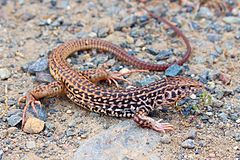Western whiptail
| Western whiptail | |
|---|---|
 |
|
| Scientific classification | |
| Kingdom: | Animalia |
| Phylum: | Chordata |
| Subphylum: | Vertebrata |
| Class: | Reptilia |
| Order: | Squamata |
| Suborder: | Sauria |
| Infraorder: | Scincomorpha |
| Family: | Teiidae |
| Genus: | Aspidoscelis |
| Species: | A. tigris |
| Binomial name | |
|
Aspidoscelis tigris (Baird & Girard, 1852) |
|
| Synonyms | |
|
|
The western whiptail (Aspidoscelis tigris) is a species of lizard in the family Teiidae. The species ranges throughout most of the southwestern United States and northern Mexico. Most of its populations appear stable, and it is not listed as endangered in any of the states comprising its range. It lives in a wide variety of habitats, including deserts and semiarid shrubland, usually in areas with sparse vegetation; it also may be found in woodland, open dry forest, and riparian growth. It lives in burrows. Major differences between this species and the checkered whiptail (Aspidoscelis tesselata) include the lack of enlarged scales anterior to the gular fold and the presence of enlarged postantebrachial scales. It was previously known as Cnemidophorus tigris, until phylogenetic analyses concluded that the genus Cnemidophorus was polyphyletic. Since it does not migrate, a number of forms have developed in different regions, several of which have been given subspecific names – for example the California whiptail, Aspidoscelis tigris munda.
The western whiptail has a long and slender body, small grainy scales on its back, and larger rectangular scales on its belly. The upper side often has light stripes, and the throat can be pinkish or somewhat orange in adults. The maximum snout-to-vent length (SVL) is 102 mm (about 4 inches), and maximum total length (including tail) is 305 mm (about 12 inches). Hatchlings are orange-yellow with dark brown-black spots or stripes.
The western whiptail is widespread throughout northern Mexico and the western United States. In the US it can be found in the states of Arizona, California, Colorado, Idaho, Nevada, New Mexico, Oregon, and Utah. It is found in hot dry regions, typically with sparse foliage. It can live in woodland, chaparral, riparian areas, or desert. Desert subspecies prefer habitat with vegetation such as sagebrush or shadscale, and rely on burrows to escape the desert heat.
...
Wikipedia

